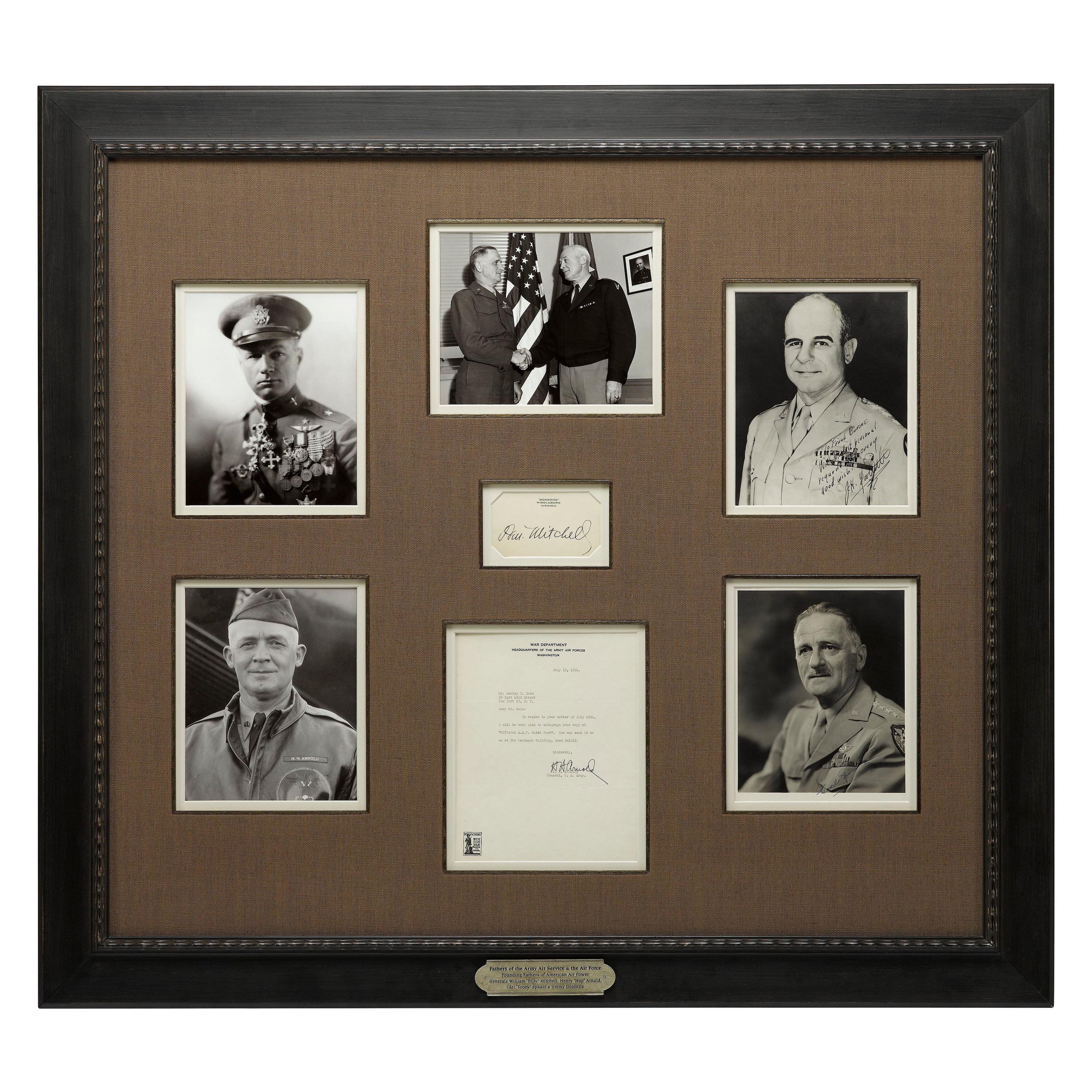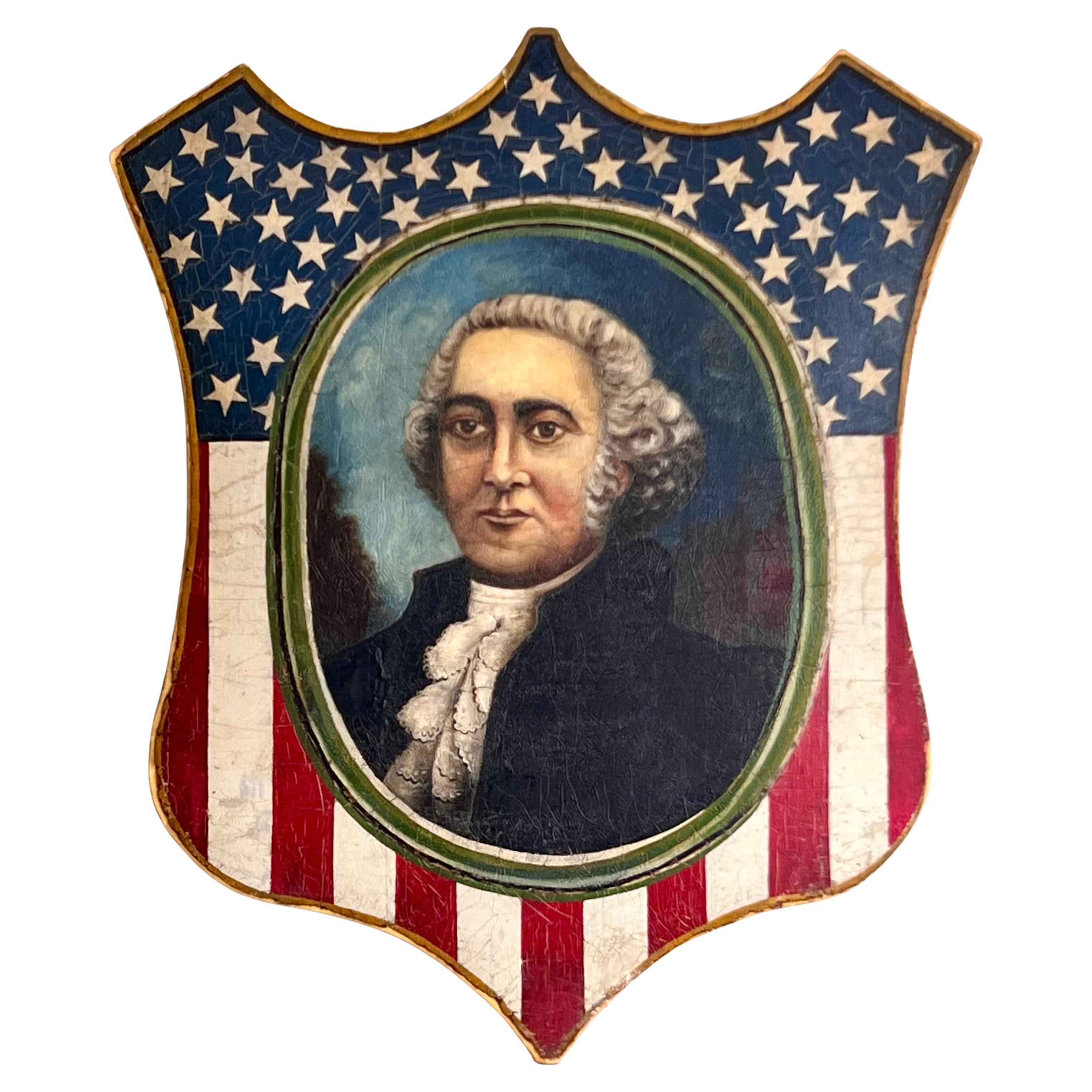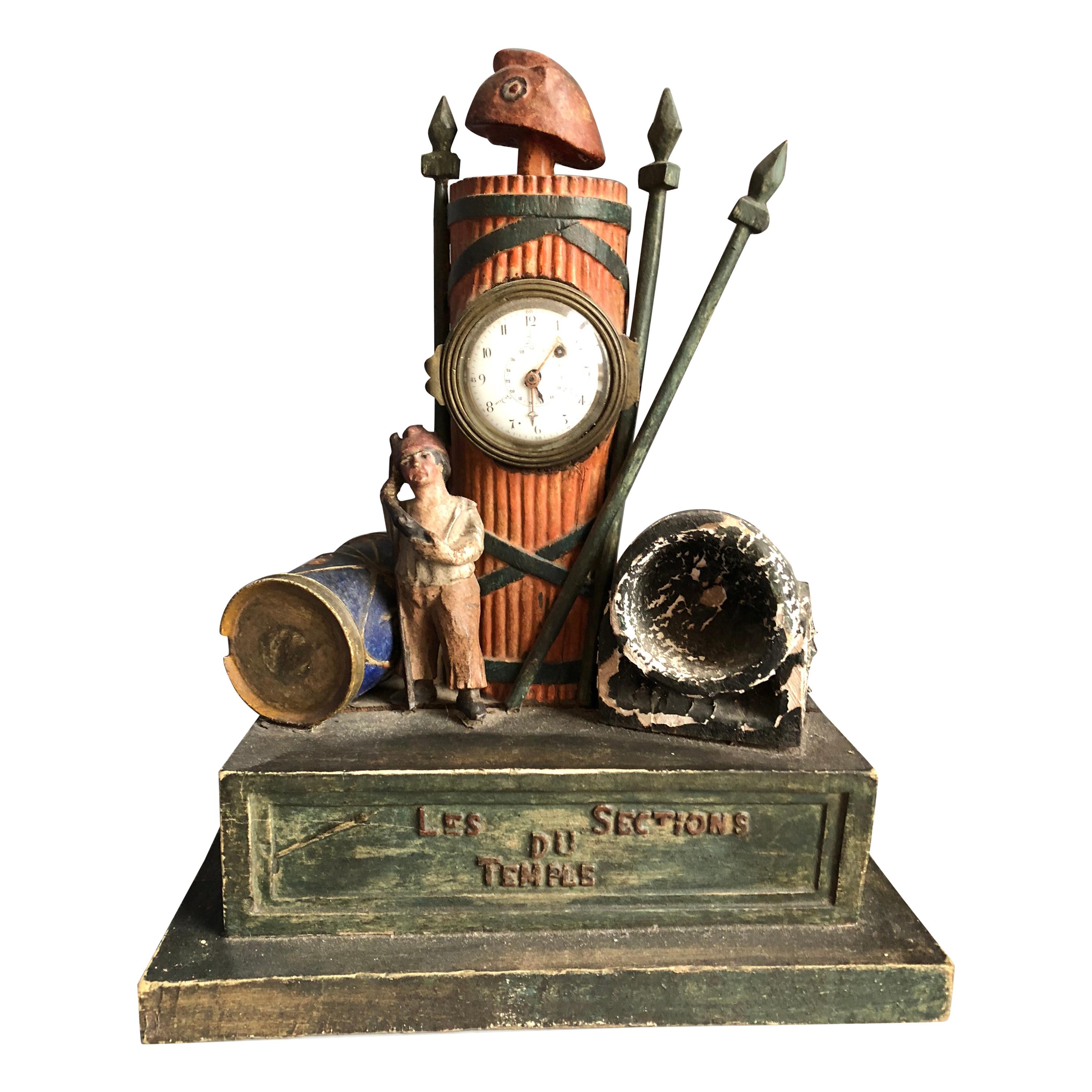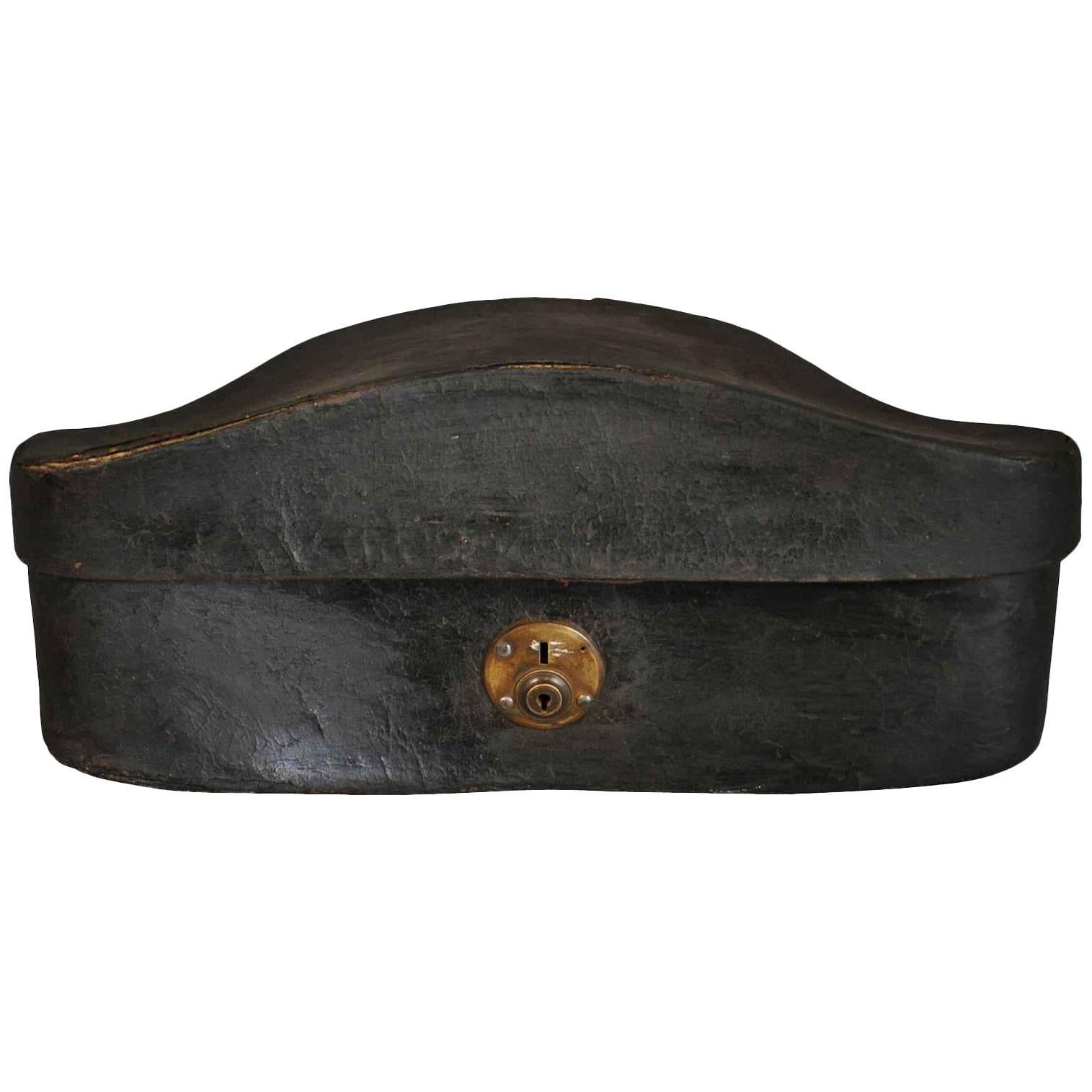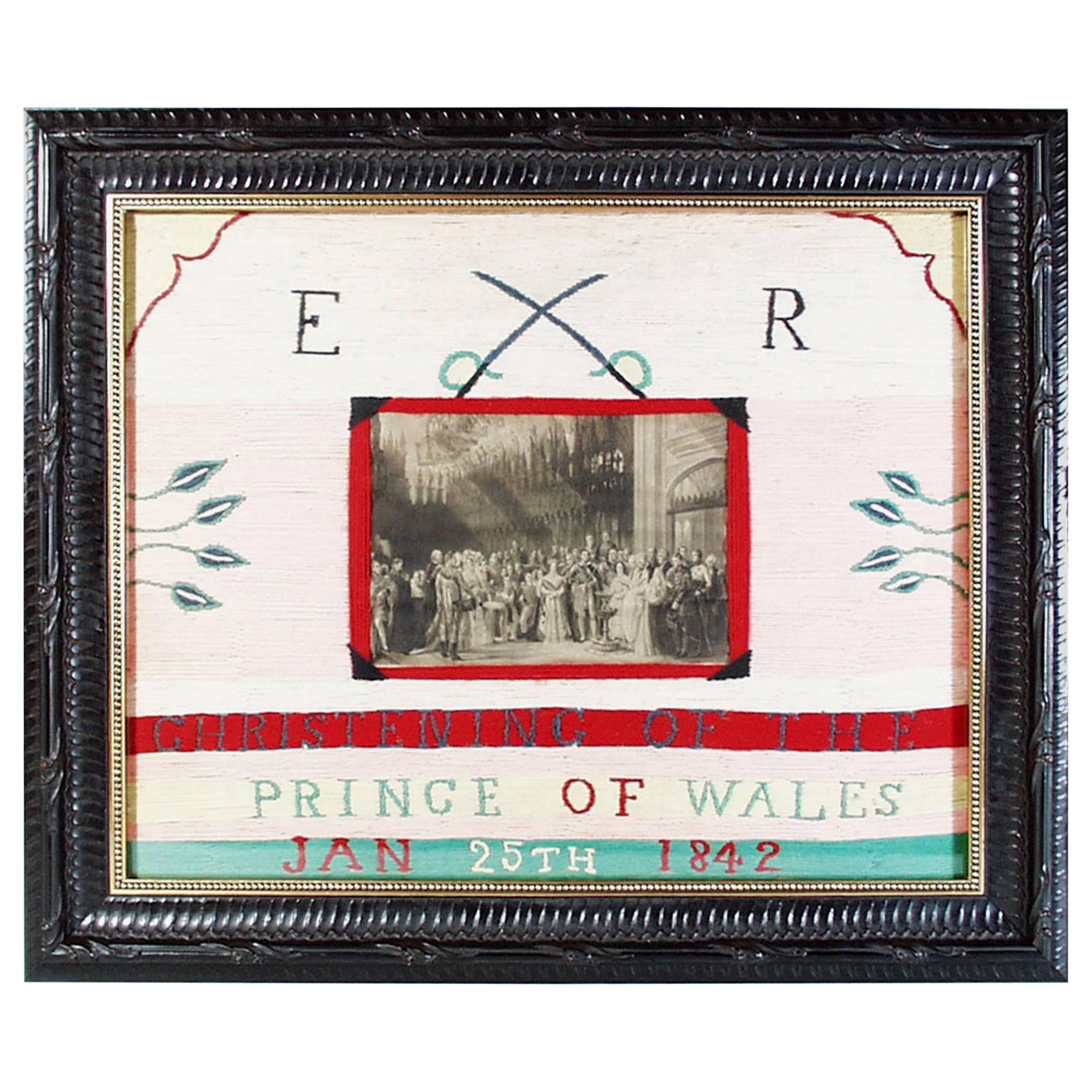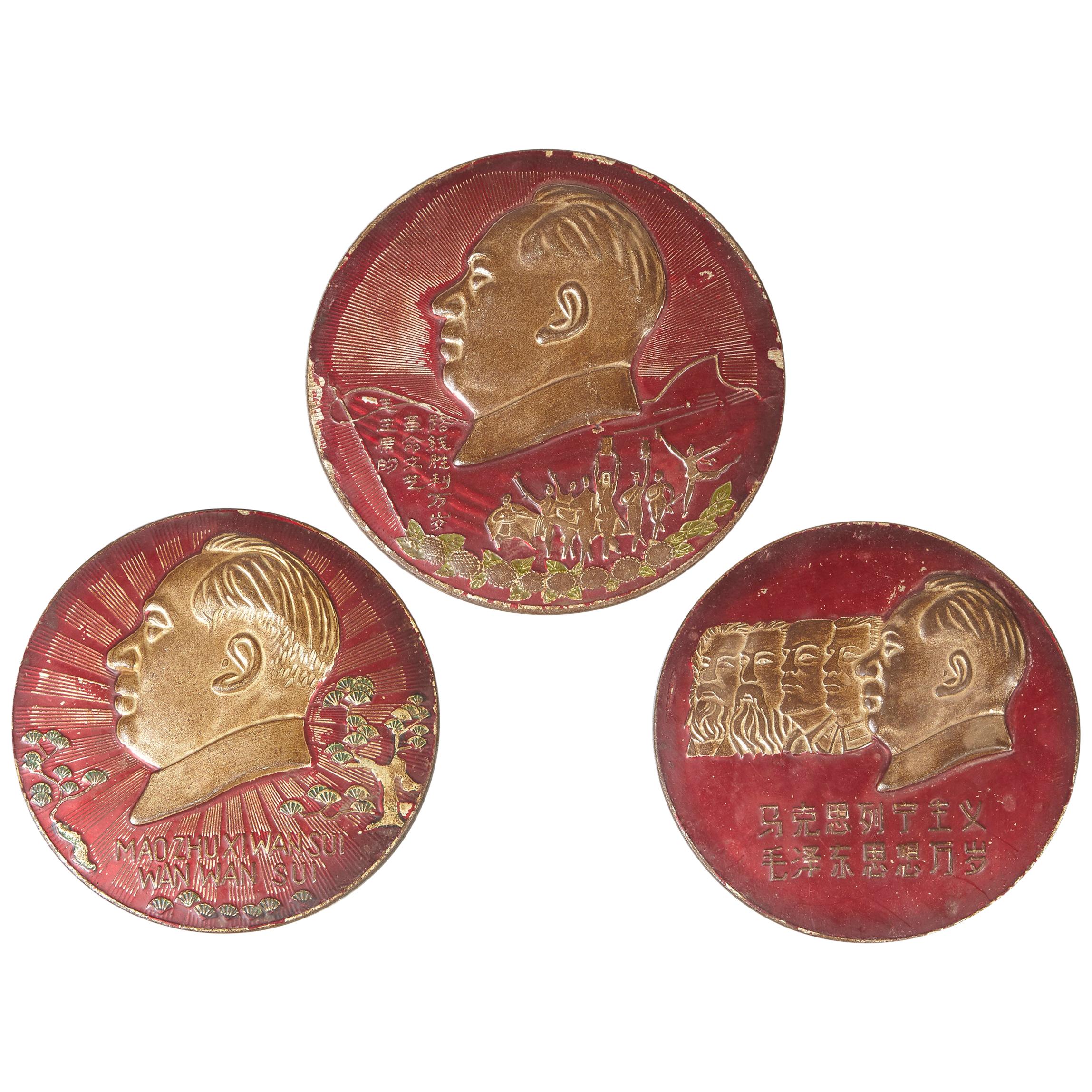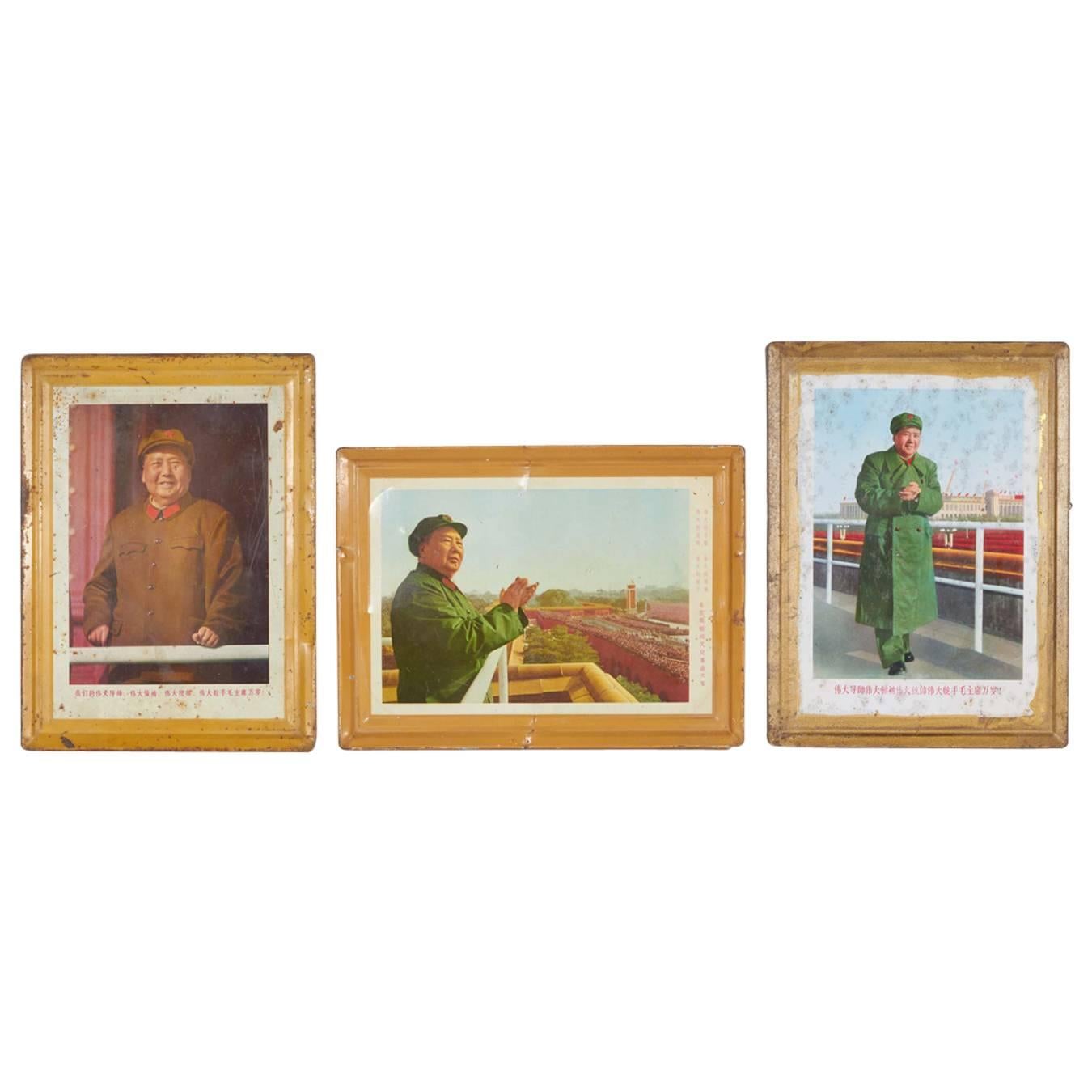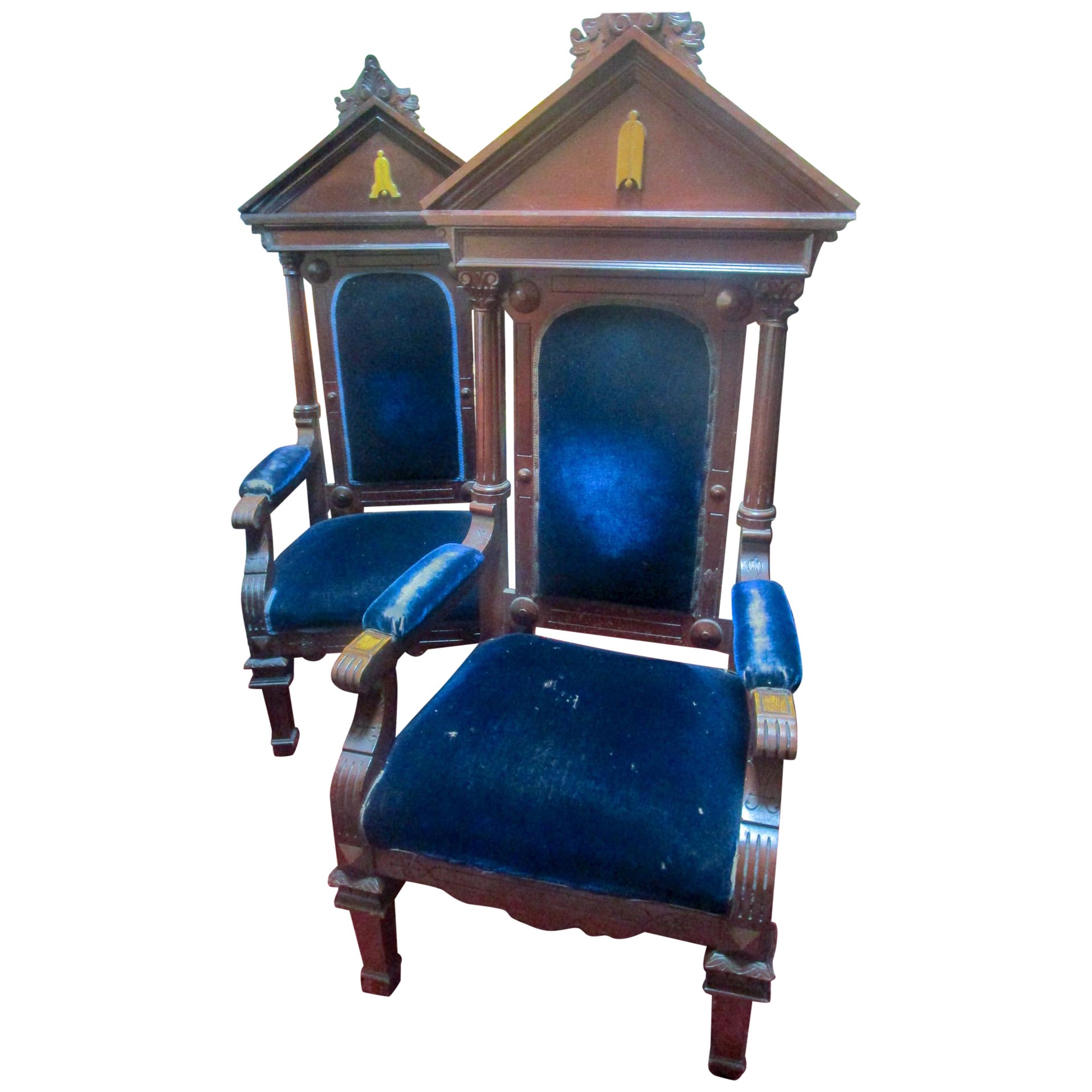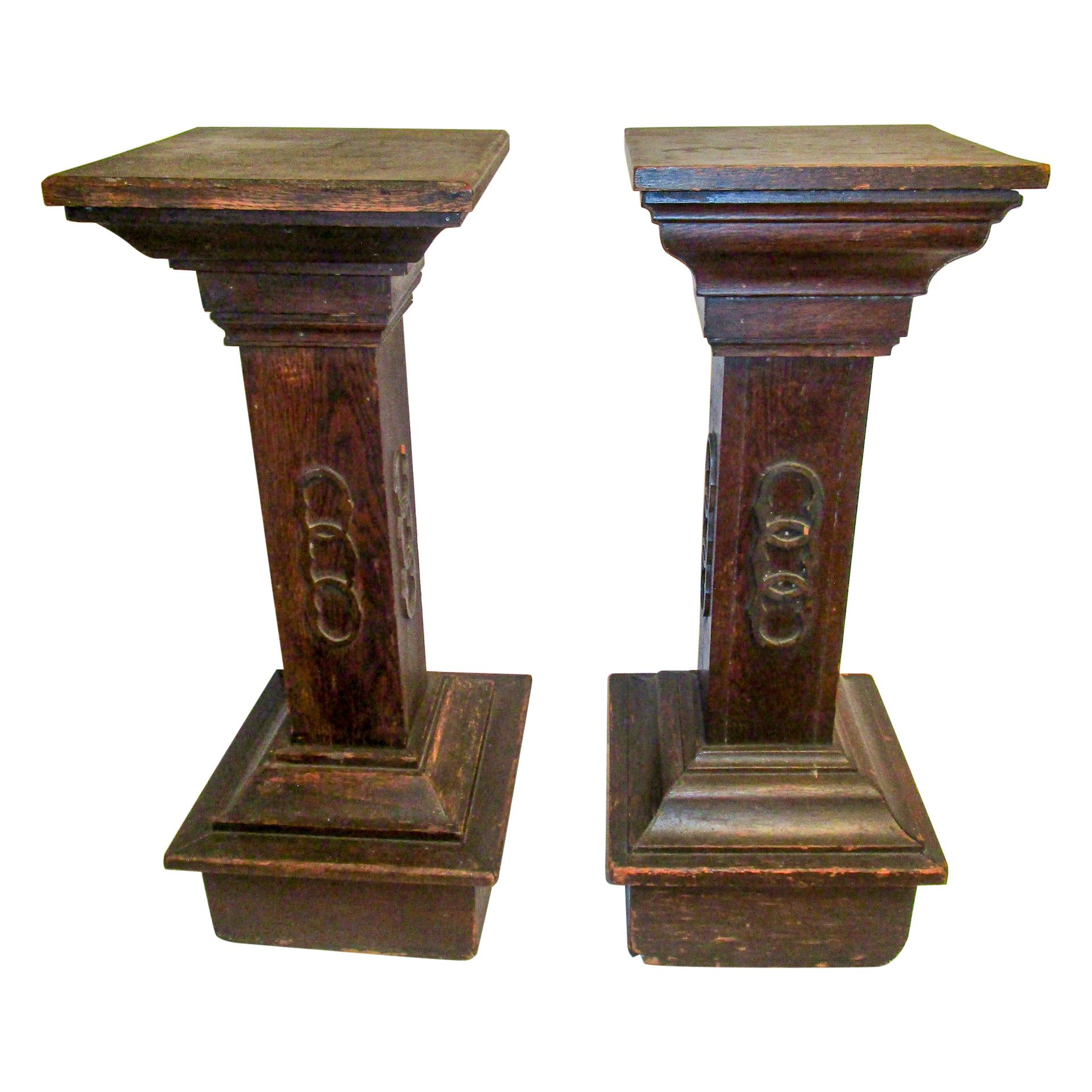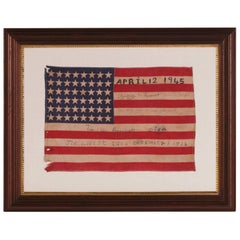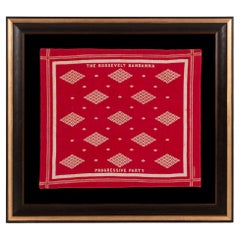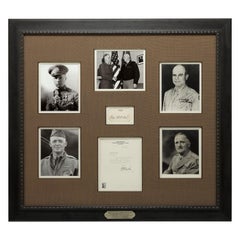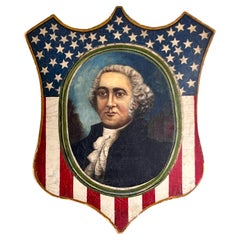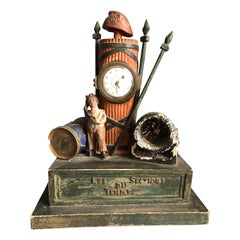
19th Century Collage Containing Many Signatures
View Similar Items
Want more images or videos?
Request additional images or videos from the seller
1 of 9
19th Century Collage Containing Many Signatures
About the Item
This unusually graphic historical collage was likely assembled sometime between 1865 and the 1890’s. It contains eight printed paper portraits, three state crests (Massachusetts, Vermont, and Missouri), and a cabinet card-type print of Lincoln’s 1861 farewell address to his neighbors; but most importantly contains no less than eighty-six signatures, almost all of which belong to Union Civil War generals, some of whom were among the most interesting personalities of the era. Among these are the following men:
● James Garfield (general, President of the United States, 1880-84 term, assassinated in 1881)
● Winfield Scott Hancock (general, 1880 presidential candidate who ran against Garfield, West Point graduate, 1844)
● John Fremont (general, the first Republican to run for president, 1856)
● Joseph K. Barnes, Surgeon General
● George Meade (General, Comm. Army of the Potomac, defeated Lee at Gettysburg, W.P., 1835)
● Philip Henry Sheridan (Cavalry Comm., Army of the Potomac, burned the Shenandoah Valley, instrumental in Lee’s surrender, W.P., 1853)
● Daniel Edgar Sickles (a famous and controversial character, lost his leg at Gettysburg)
● John Gibbon (Comm. the Iron Brigade, gave them their black hats, W.P., 1847)
● John Adams Dix (Outranked all volunteer officers, as he was first on the list on May 16 1861. Governor of New York, U.S. Senator, Secretary of the Treasury, namesake of Ft. Dix, NJ)
● Joseph Jones (J.J.) Reynolds (Chief of Staff, Army of the Cumberland, W.P., 1843)
● Joseph Hooker (Comm. Army of the Potomac at Chancellorsville, W.P., 1837)
● John McAllister Schofield (namesake of Schofield Barracks, W.P., 1853)
● John Pope (W.P., 1842)
● George Henry “Pap” Thomas (Comm. Army of the Cumberland, W.P., 1840)
● Andrew Atkinson Humphreys (Aide to McClellan, Chief of Staff to Meade, W.P., 1831)
● Jefferson C. Davis (killed Gen. William Nelson in a quarrel, 1862)
● Frederick Steele (W.P., 1843)
● John James Peck (W.P., 1843)
● Oliver Otis Howard (W.P., 1854)
● Irvin McDowell (W.P., 1838)
● Rufus Saxton (W.P., 1849)
And many others who I have either not yet recorded or identified.
Mounting: This is a sandwich mount between 100% cotton velvet and u.v. protective plexiglas. The frame is a black-painted, gilded, and distressed Italian molding.
- Materials and Techniques:
- Place of Origin:
- Period:
- Date of Manufacture:1895-1890
- Condition:Condition: There is foxing throughout.
- Seller Location:York County, PA
- Reference Number:Seller: pat-0911stDibs: U080721849765
About the Seller
5.0
Recognized Seller
These prestigious sellers are industry leaders and represent the highest echelon for item quality and design.
Established in 1991
1stDibs seller since 2008
61 sales on 1stDibs
Typical response time: 10 hours
More From This SellerView All
- Hand-Painted 19th Century Banner with the 1867 Proposed Seal of IllinoisLocated in York County, PAHAND-PAINTED 19TH CENTURY BANNER WITH AN 1867 VERSION OF THE SEAL OF THE STATE OF ILLINOIS, PROPOSED IN THAT YEAR BY THE SECRETARY OF STATE, BUT IN A VARIATION NEVER FORMALLY ADOPTED Banner with the Illinois State Seal, in a rare variation of the design, never adopted. In 1867 Illinois Secretary of State Sharon Tyndale proposed that the phrases in the state motto be reversed. In the wake of the Civil War, (which ended in 1865,) Tyndale suggested that the verbiage be changed from "State Sovereignty--National Union" to "National Union--State Sovereignty,” which made sense given the recent secession of the Southern States, which placed their own interests first. Illinois' own Abraham Lincoln had worked hard to preserve national interests, echoed here in the altering of the language. Though Tyndale’s suggestion was rejected, he was nonetheless charged with creating a new design, which he did and was soon adopted. This displayed the dates of "1818," when Illinois became a state, and "1868," when the seal was officially changed. Interestingly enough, Tyndale did manage to send a message in the new version by turning the word “sovereignty” upside-down , with the surmised explanation that this fit accordingly with the orientation / position of the streamer. The banner is beautifully hand-painted on muslin and retains its original staff. The shape is beautifully scalloped at the bottom edge, which is painted to look as if there is an applied fringe. Most of the elements are congruent with the 1868 version, but there are various differences. Set within a shield-shaped medallion—usually circular—is the expected eagle in a side view, spread wing pose with beak uplifted. The eagle is supposed to be perched upon a rock with one talon, while gripping a Federal shield in the other. Here there is no rock and both talons grip the shield, which displays 13 stars. Note the date of "1867" and Tyndale's preferred order of the wording on the billowing ribbon in the eagle's beak. The foreground of the official design is all grass. Here there are olive branches—a peacetime reference appropriate for a country recovering from war—on a grassy area, set upon a sandy shore before Lake Michigan, with a rising sun on the horizon. Mounting: The banner was mounted and framed within our own conservation department, which is led by masters degree trained staff. We take great care in the mounting and presentation of flags and have preserved thousands of examples; more than anyone worldwide. The background is 100% cotton twill, black in color. The mount was placed in a black-painted, hand-gilded and distressed Italian molding. A shadowbox was created to accommodate the staff. The glazing is U.V. protective plexiglass. Feel free to contact us for more details. Banner - 49" x 56.5" Frame - 67.75" x 59.25" About Jeff R. Bridgman Antiques, Inc.: As an advisor to top museums and collectors alike, Jeff Bridgman is the world's leading expert and source for antique American flags and political textiles...Category
Antique 1860s American Political and Patriotic Memorabilia
MaterialsCotton
Price Upon Request - Antique American Flag w/ Hand-Written Inscriptions Mourning the Death of FDRLocated in York County, PA48 STARS ON ANTIQUE AMERICAN FLAG WITH HAND-WRITTEN INSCRIPTIONS AND AN EMBROIDERED DATE OF APRIL 12TH, 1945, MOURNING THE DEATH OF PRESIDENT FRANKLIN DELANO ROOSEVELT: American national parade flag with 48 stars, printed on cotton, embellished with hand-written inscriptions and an embroidered date to commemorate the death of FDR on April 12th, 1945. “On this day in 1945, President Franklin D. Roosevelt died of a massive cerebral hemorrhage at his Warm Springs, Georgia, retreat at the age of 63. Roosevelt’s death in the final months of World War II was met with shock and grief throughout the Western world. Many Americans had no inkling of his decline in health. [He] had been president for more than 12 years, longer than any other person. He led the country through some of its greatest domestic and foreign crises to the impending defeat of Nazi Germany and within sight of Japan’s surrender...Category
Vintage 1940s American Political and Patriotic Memorabilia
MaterialsCotton
- 1912 Roosevelt Turkey Red Bandana, ca 1912Located in York County, PATurkey red bandanna, made for the 1912 presidential campaign of teddy Roosevelt, when he ran on the independent, progressive party (bull moose) ticket Printed cotton kerchief, made for the 1912 presidential campaign of Theodore Roosevelt when he ran on the Progressive Party ticket (a.k.a., the Bull Moose campaign). This graphic textile, in a classic, western style, typical of the iconic red bandanna, is indicative of both the Republican Party in the late 19th century, and T.R.’s love of the American West. In this example, a geometric design with diamonds, surrounded by multiple, linear borders, is accompanied by the following text along the top and bottom that reads: “The Roosevelt Bandanna” and “Progressive Party,” respectively. A maker’s mark in the lower right corner reads “Cochranes Mfg. Co.” Cochrane’s was known for their long-lasting, red dye process, called “Cochrane’s Turkey Red.”. It was really a process, as opposed to a dye itself, to which the name applied. The dye was actually a derived from a synthetic colorant called “alizarin,” imported by Alexander Cochrane’s family, who emigrated to the United States from 1847, and owned a chemical company in Massachusetts that produced the dye. The fabrics were produced by the family of John Cochrane, who emigrated from Renfrewshire, Scotland in 1844. Both families, who resided in Malden, Massachusetts initially, traced their ancestry to Barrhead, Scotland, in the heart of the textile-producing region, near Glasgow and Paisley. It was in Glascow that Turkey Red printed bandannas are said to have originated, in the shop of Henry Monteith & Company, in 1802.* TR's decision to enter the 1912 election was not exactly popular among many of his friends and former supporters. His participation manifested into a unique political incident, in which the independent, Roosevelt, beat out a major party ticket, garnering 27.4% of the vote. At the same time, however, he lost the White House, not only for himself, but for his former Republican friends as well, by dividing support between his own candidacy and that of incumbent President William Howard Taft...Category
Vintage 1910s American Political and Patriotic Memorabilia
MaterialsCotton
- Cast Iron Boot Jack Made for 1864 Presidential Campaign of George McClellanLocated in York County, PACAST IRON BOOT JACK, MADE FOR THE 1864 PRESIDENTIAL CAMPAIGN OF GENERAL GEORGE B. MC CLELLAN, WITH A FANTASTIC SLOGAN THAT READS "THE UNION AT ALL HAZZARDS" Made for the 1864 presidential run of George B. McClellan, this cast iron bootjack is both rare and graphically exceptional. Displaying the original black-painted surface, with attractive and desirable patina, the stylized profile has a wonderful folk art quality. Molded block letters that wrap around the heel clasp read simply "Gen. Mc Clellan. These are accompanied by a prominent Civil War-associated slogan: "The Union at all Hazards." The text is intermingled with 34 stars, which was equivalent to the number of states during the opening two years of the war, but was one star short by mid-1863 and two stars short by the time of the actual election in 1864. It's not unusual to encounter this feature in civil war campaign parade flags as well as all manner of flag-related ephemera. The iron was reportedly cast by G. & D. Cross of Morrisville, New York, though it is unsigned and I have not yet verified the attribution. I have seen two other examples, one of which had a broken and repaired tine on the U-shaped horns and newly painted surface, while the other appeared to have broken lifters and inferior, rusted patina. This is, hands-down, the best of the identified examples. Brief History of the 1864 Campaign: President Abraham Lincoln had a checkered relationship with his 1864 opponent, who he had formerly chosen as General-in-Chief of the entire Union Army. The career officer repeatedly knocked heads with his Commander-in-Chief. Having raised a well-trained and organized military force, McClellan often seemed reluctant to use it. By 1862, after losses in Virginia during the Peninsula Campaign, Lincoln grew frustrated with McClellan and the progression of the war and removed him from command. By the early part of 1864 the American people shared some of the same frustrations and Lincoln was no longer the clear choice for the White House. The nation was tired of war and the remains of the Democratic Party...Category
Antique 1860s American Political and Patriotic Memorabilia
MaterialsIron
- 38 Star Antique American Flag by Horstman Brothers, Colorado Statehood, ca 1876Located in York County, PA38 CANTED STARS IN STAGGERED ROWS, ON A CLAMP-DYED, WOOL, ANTIQUE AMERICAN FLAG MADE BY THE HORSTMANN BROTHERS IN PHILADELPHIA, ALMOST CERTAINLY FOR DISPLAY AT THE 1876 CENTENNIAL EXPOSITION; A VERY RARE EXAMPLE WITH STRONG COLORS AND GREAT TEXTURE; REFLECTS COLORADO STATEHOOD 38 star American flag, press-dyed on wool bunting, with wonderful texture and great colors. Made by Horstmann Brothers of Philadelphia, a major military outfitter, the flag is signed along the hoist with a black stencil. The stars of the flag are arranged in lineal rows of 8-7-8-7-8. Note how these are universally canted, with one point directed at roughly 11:00, when the flag is viewed on the obverse (front). This particular style of flag, from Horstmann, is exceedingly rare. Measuring approximately two by three feet, I know of just four examples in total, including this flag, all of which I have had the great privilege to own. The first two I acquired about 20 years ago. I was not yet taking digital imagery at the time, and cannot seem to locate them among my files of hard copy prints and negatives. I believe they displayed in the same configuration of staggered rows. The example that I owned more recently bore the staggered row layout, but had exceedingly crude printing, whimsical and interesting in its own right. All, I believe, have displayed their stars slightly canted at an angle, like the flag that is the subject of this narrative. A close variation that I acquired about 11 or 12 years ago also had canted stars. It was in the same scale and shared the same 8-7-8-7-8 distribution, but the rows were not staggered. Instead these were justified toward the fly end. Because the spacing was inconsistent, the resulting formation was not what one might expect, with perfect spaces for two additional stars along the hoist end (a “notched” pattern). Horstman flags made of press-dyed wool sometimes had formal bindings, sometimes had a length of fabric tape stitched along the hoist, and sometimes had no binding at all. This one has a traditional binding, made of heavy cotton twill, in the form of an open sleeve, treadle-sewn along the hoist. Near the top of this, “2 x 3 Ft.” appears in a black inked stencil, near the top, accompanied by “Horstmann. Phila.” Near the bottom. Colorado became the 38th state on August 1st, 1876. This was the year of our nation’s 100-year anniversary of independence. Per the Third Flag Act of 1818, stars were not officially added until the 4th of July following a state's addition. For this reason, 37 was the official star count for the American flag in 1876. Flag-making was a competitive venture, however, and few flag-makers would have continued to produce 37 star flags when their competitors were making 38’s. It is for this reason that 38 and 13 stars (to represent the original 13 colonies) are more often seen at the Centennial Expo. Some flag-makers would have been adding a star for the 38th state even before it entered the Union, in the early part of 1876 or even prior. In fact, many makers of parade flags were actually producing 39 star flags, in hopeful anticipation of the addition of two more Western Territories instead of one. But the 39th state would not join the Union for another 13 years, when the Dakota Territory entered as two states on the same day. The 38 star flag became official on July 4th, 1877 and was generally used until the addition of the Dakotas in 1889. Press-dyed wool flags are scarcer than those printed on cotton and silk. Because parade flags were often intended for one day's use at a parade, political rally, a reunion of soldiers, or some other patriotic event, most were made of cotton. While cotton absorbs water, short-term use precluded the need for anything more hardy. Because the Centennial Exposition lasted for a period of six months, it required decorative flags that would sustain being flown for a longer time and withstand the elements. It is reasonable to assume that press-dyed wool flags were adapted for precisely this purpose, because wool sheds water is suitable for extended outdoor use. Previous to this time they primarily saw military function. A Brief History of the Horstmann Company: William H. Horstmann (1785-1850) was the founder of what would become a major military outfitter in both Philadelphia and New York City. A solider and fourth generation passementier (textile weaver), he emigrated to the United States from Germany in 1816 and settled in the Germantown area of Philadelphia, where there was a significant concentration of textile manufacture. There he married the daughter of the most successful lace manufacturing firm, and started his own business in coach lace and military goods at the corner of 59 North 3rd Street. He imported looms from Germany and elsewhere and maintained a regular trade with his family in Europe. The company grew exponentially in size and had many addresses over its years of operation. In 1828, the William H. Horstmann Military Store opened. In 1843 it became William H. Horstmann & Sons Military Store, and in 1859 it was taken over by sons, Sigmund H. and William J., and began to operate as Horstmann Bros. & Co. The company manufactured its own goods, including flags, swords, drums, insignia, and many other items, and it subcontracted their manufacture as well, depending on financial sensibility. There were investors along the way, such as William S. Hassall and George Evans, who broke off and began their own large and successful firm. The New York branch changed its name in 1877 to that of a Horstmann partner, H.V. Allien. Both Philadelphia and New York branches filed for bankruptcy and closed in 1948. Because of its Philadelphia location, Horstmann was in a unique position to supply flags and banners to the 1876 Centennial International Exposition, and thus served an integral role in decorating the enormous, six-month long event. It is logical to presume that this extremely interesting and rare flag...Category
Antique 1870s American Political and Patriotic Memorabilia
MaterialsCotton
- 34 STAR AMERICAN FLAG, CIVIL WAR, 1861-63, KANSAS STATEHOOD, 2nd KY CAVALRYLocated in York County, PA34 STAR ANTIQUE AMERICAN FLAG OF THE CIVIL WAR PERIOD (1861-63), IN A TINY SCALE AMONG PIECED-AND-SEWN FLAGS OF THE PERIOD, WITH A TRIPLE-WREATH CONFIGURATION, AN ELONGATED FORMAT, AND ENTIRELY HAND-SEWN; FOUND WITH A LETTER FROM JOHN W. RUDE OF THE 2ND KENTUCKY VETERAN VOLUNTEER CAVALRY (UNION): 34 star flag of the Civil War period with a variety of extremely desirable features, handed down with a letter written by John W. Rude on November 8th, 1864, while encamped with the Army’s 1st Brigade, 3rd Division, as a member of the 2nd Regiment of Veteran Volunteer Cavalry. Tiny in scale among pieced and sewn examples, the flag displays a star pattern that consists of a three consecutive wreaths, with a single star in the very center. Because it lacks a single star in each corner, outside the basic pattern—usually present in flags of this design made during the mid-late 19th century—this is something I classify as a “snowball medallion.” Entirely hand-sewn throughout, note the square format of the blue canton, with its beautiful, circular star arrangement, and how interesting this combination is when paired with the elongated format of the flag itself. The stars are double-appliqued, meaning that they are applied to both sides. These are fat in shape and inconsistent in size. Note how the lowest star in the outermost ring actually dips into the white stripe below. Made of plain weave cotton, there is a narrow binding along the hoist, red in color, with three sets of cotton ties. Those at the top and bottom are made of fine, braided hemp or hemp and cotton cord, stitched into place, while the one in the center, looped around the binding and tied, is made of lightweight, twisted, cotton thread. Note how the 5th, 6th, and 7th red stripes are pieced from two lengths of cotton fabric, which reflects that the maker was being conscious of conserving available fabric. In the 19th century, most flags with pieced and sewn construction were 8 feet long and larger. A six-footer was considered small. Even military battle flags, carried on foot, measured 6’ x 6.5’, which translates into approximately 7’ x 7.5’ after framing, about the size of an average quilt and larger than can comfortably fit on a wall in a house with 8-foot ceilings and average width baseboard. Flags smaller than this exist, but the smaller they get, the more unusual they are. At just 1.5’ x 3’, this is about as small as one will ever encounter in a sewn flag of the Civil War era. The flag appears to have likely been hand-carried. I expect that it probably saw military use of some sort as a camp flag...Category
Antique 1860s American Political and Patriotic Memorabilia
MaterialsCotton
You May Also Like
- Fathers of the Air Service Authentic Signature Collage, circa 1926-1993Located in Colorado Springs, COPresented is a collage celebrating the men who made an early impact on the formation of America’s Air Service. Complete with signatures by Jimmy Doolittle, Tooey Spaatz, Hap Arnold, ...Category
Late 20th Century American Historical Memorabilia
MaterialsPaper
- 19th Century Patriotic Shield Painting Featuring John AdamsLocated in Wiscasset, MEFolk art patriotic shield painting of John Adams, dating to around 1876 and of a large size measuring 41" x 34.5". It is an oil on canvas laid down to boards. There is writing on the back of the boards, but I cannot make out what it says. There is another similar piece to this that features another signer of the constitution in the Smithsonian collection. This piece came from a collection in Portsmouth...Category
Antique 19th Century American Folk Art Paintings
MaterialsPaint
- Folk Art French Revolution Clock, Early 19th CenturyLocated in Doylestown, PAA French folk-art figural mantel clock in carved wood and composite commemorating a fighting unit “Les Sections du Temple” in the French Revolution. The clock depicts a single figure “sans culots” with a walking stick flanked on one side by a drum and on the other by a black mortar...Category
Antique Early 19th Century French French Provincial Mantel Clocks
MaterialsWood
$3,250 Sale Price43% Off - Sensational Early 19th Century Chapeau De Gendarme Hat BoxLocated in Atlanta, GAA sensational early 19th century French Chapeau De Gendarme - officer's hat box in leather. Such a nostalgic shape!! A great accent piece for any b...Category
Antique Early 19th Century French Arms, Armor and Weapons
MaterialsLeather
- Christening of the Prince of Wales Woolwork Picture, Dated 1842Located in Downingtown, PAEnglish Royal Woolwork Picture, Titled E R/ Christening of the/Prince of Wales/Jan 25th 1842. A rare woolwork picture in bands of white, pink, red and green centered with a black and white picture...Category
Antique Mid-19th Century English Folk Art Decorative Art
MaterialsWool
- Three Embossed Metal Cultural Revolution Plaques with Images of MaoLocated in New York, NYThree cultural revolution period embossed metal plaques, each with the image of Chairman Mao, one plaque also including images of the leaders of Russian communism. Priced and sold ...Category
Late 20th Century Chinese Decorative Art
MaterialsMetal
